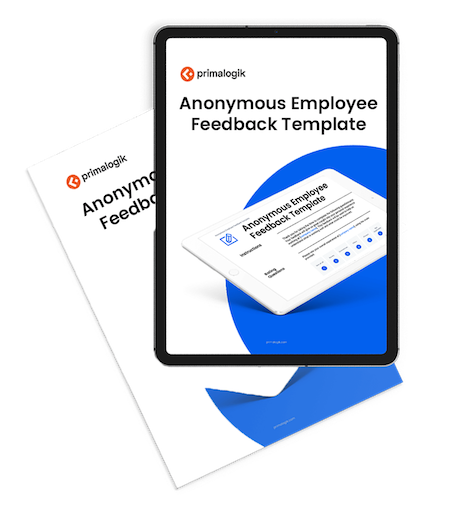Good feedback is the backbone of a solid team. But what is anonymous employee feedback? Simply put, it consists of feedback that can’t be connected to any individual employee. HR, leaders, or managers can use special tools to maintain anonymity while gathering this feedback. Such tools collect no identifying data that the recipient could view.
Importantly, anonymous feedback and confidential feedback aren’t the same thing. With confidential feedback, the person administering a survey or interview knows who gave the feedback. For instance, an HR manager holding stay interviews may promise to keep feedback confidential.
This means no one else will learn the identity of an employee who gave specific feedback. Let’s explore the benefits of anonymous employee feedback—and how to solicit it.
Table of Contents
1. Why You Need Anonymous Employee Feedback
2. Drawbacks of Anonymous Employee Feedback
3. Different Types of Anonymous Employee Feedback
4. How to Gather Anonymous Employee Feedback
5. FAQs
Why You Need Anonymous Employee Feedback
What are the main benefits of anonymous employee feedback? Most notably, it makes employees feel safe to speak up honestly. That has the following far-reaching benefits:
- Improving workplace morale by making employees feel heard
- Delivering new ideas for how to strengthen processes and practices
- Helping leaders and managers understand their workforce better
- Creating a stronger, more supportive workplace culture
- Increasing retention by better meeting employees’ needs
- Developing a high-performing team
The ability to give feedback anonymously makes 74% of employees more likely to share their opinions. When dealing with sensitive topics, employees may fear they’ll experience some form of backlash from sharing feedback. With anonymous feedback channels, they don’t have to worry.
Consider that 41% of employees have walked away from a job because they felt their voice wasn’t being heard. Meanwhile, 36% of organisations don’t have a feedback program in place. Businesses could avoid countless resignations simply by listening to and acting on employee feedback.
“Organisation responsiveness to employee feedback leads to higher retention rates, lower absenteeism, improved productivity, better customer service and higher employee morale,” says the Society for Human Resource Management (SHRM). The key word is “responsiveness,” as we’ll explore in a moment.

Drawbacks of Anonymous Employee Feedback
Are there any times when you wouldn’t want feedback to be anonymous? And what are the potential drawbacks?
First, you can’t directly ask follow-up questions with anonymous feedback. However, you can send out a follow-up survey with these questions. You just won’t be asking one individual specifically.
Second, with open-ended feedback, employees’ answers could lend clues about who they are. A manager reviewing them may pick up on who said what.
Third, face-to-face feedback can build relationships when there is a foundation of trust. So, anonymous feedback isn’t right for every context. Managers and employees should talk candidly during regular informal check-ins, for instance.
In short, anonymous feedback has both drawbacks and advantages. You wouldn’t want all of your feedback to be anonymous. So, make specific feedback channels anonymous while others are simply confidential—and make it clear which is which.
Different Types of Anonymous Employee Feedback
Anonymous employee feedback can take several different forms. Here are several tools that allow you to collect a specific type of anonymous employee feedback.
- Pulse surveys. These short, periodic surveys can be easily completed in a few minutes. Plus, employee survey software can synthesise results and glean key findings.
- Suggestion boxes. Whether real or virtual, suggestion boxes allow employees to submit concerns and ideas that arise in the moment.
- 360-degree feedback software. Through 360 surveys, employees can provide valuable feedback for peers—and for their managers.
Now, let’s explore how to use these tools as effectively as possible.
How to Gather Anonymous Employee Feedback

Employee feedback is more likely to deliver value when you’re consistent about collecting it. Implement a great anonymous employee feedback process through these steps.
Best Practices for Gathering Anonymous Feedback
Take these steps to gain candid feedback from employees.
- Avoid asking for demographic details, if possible. Forms that have workers fill out salary, job level, and years of service can reduce anonymity.
- Explain how the process ensures anonymity, speaking to their concerns. For instance, “Your manager couldn’t see your survey responses even if they wanted to. Instead, they’ll just see the synthesised results from all employees. And even HR leaders don’t have access to identifying information.”
- Provide specific prompts for open-ended responses. Pulse surveys can focus on specific topics to provide more in-depth insights.
- Don’t ask questions that require details that could identify respondents. For instance, “When did your manager last meet with you one on one?” could reveal which direct report is responding.
- On 360 reviews, distill open-ended responses into your own words. People often have their own distinct ways of phrasing things, which can make responses less anonymous. Hence, when sharing results with the person under review, synthesise or paraphrase the answers.
- Use tools that automatically prompt respondents to complete a survey. Let them know that any reminders to complete the survey have been automatically sent by the survey software—not manually by an HR manager.
- Ask for feedback even during times of disruption—not just when things are going smoothly. As Gallup says, it’s especially important to ask for feedback in a crisis. You’ll improve your response as a company by doing so.
- Take action to address employee concerns. Let them know what you’re planning. Knowing you’re taking their feedback seriously will greatly boost morale.
Now, let’s dive into great questions to ask.

Download Now: Free Anonymous Employee Feedback Template [Get Your Copy]
Anonymous Employee Feedback Questions
Asking the right questions will garner accurate and thoughtful responses. Here are some good ones to incorporate into your surveys.
The following rating questions can include a scale from “Not at all” to “Absolutely” or a numeric rating scale.
- Do you perceive our organisation as transparent with employees?
- Do you have the tools to collaborate effectively with your team?
- Does your manager support you in setting strong professional goals?
- Does your manager equip you to achieve these goals?
- Do you feel your opinions matter at work?
- Does team communication flow smoothly?
- Do you have a strong understanding of workflow processes?
- Do you know what your manager expects of you?
- Do you feel equipped to make good decisions within your role?
Additionally, you can include questions that ask for a written response, like these:
- What would strengthen your team’s communication?
- How would you like your relationship with your manager to improve?
- In what ways could the organisation become more transparent?
- How often do you receive constructive feedback?
- How often do you receive recognition for your work?
Additionally, Gallup shares 12 questions that can assess employee engagement. Dubbed the Q12, they can also help managers assess how well they’re supporting employees.
Anonymous Employee Feedback Template + Examples
Here is a sample employee survey along with response examples. Feel free to customise our template to fit your organisation’s requirements.
Pulse Survey: Employee Satisfaction
Rate your level of agreement with each of the first seven statements (with 5 being the highest).
Date: __________
My team appreciates my efforts. 1 2 3 4 5
My goals are challenging, but not too challenging. 1 2 3 4 5
I enjoy collaborating with my team. 1 2 3 4 5
I enjoy most of the work I do on a daily basis. 1 2 3 4 5
My work leverages my skill set. 1 2 3 4 5
I have exciting professional goals. 1 2 3 4 5
I have a clear plan for achieving these goals. 1 2 3 4 5
Please provide detailed responses to the following questions.
How often does your manager meet with you one on one?
_________________________________________________________________________________________________________________________
What do you enjoy most about your work?
_________________________________________________________________________________________________________________________
How much of your time do you spend focused on what you enjoy?
_________________________________________________________________________________________________________________________
In the past month, have you felt appreciated at work? Describe.
_________________________________________________________________________________________________________________________
Thank you! Your responses will be synthesized with those of other employees. Anonymity will be fully maintained as we consider and respond to this feedback.
Anonymous Employee
Feedback Template
Wondering what to ask when gathering anonymous employee feedback? This template includes 11 questions to ask employees to understand their work experience.
FAQs

Here are some key questions on anonymous employee feedback that we hear frequently.
How can you reassure employees that feedback is really anonymous?
Describe the tech solutions you’re using. Explain how they function to build the credibility of your process. When people know you’re taking anonymity seriously by investing in these solutions, trust will increase.
What if you have follow-up questions about feedback?
You can pose general questions to the team rather than to one individual. Let them know you’re eager to get more input on the topic from anyone who can speak to it.
If you suspect you know who shared the feedback, is it ever okay to reach out?
No, as that would undermine trust in the process. Even if you’re just trying to understand their perspective better, this can decrease their comfort in taking part in future surveys. As mentioned above, it’s best to ask everyone the same questions rather than targeting individuals.
You can do this with the group or privately. In either case, make it clear that you’re asking everyone these questions. You may draw forth important insights from multiple people.
In Conclusion
By taking anonymous employee feedback seriously, you’ll strengthen your culture and workplace morale. Employees will feel more comfortable speaking up about issues large and small. As a result, your organisation will achieve a higher level of performance—and keep it growing.
Learn how survey software and other tools can boost your employees’ performance. Sign up to demo our product.





